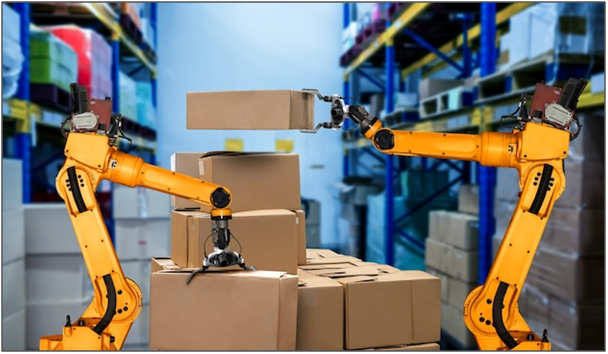Digital Innovations explores the transformative impact of cutting-edge technologies on inventory control strategies. This article examines key innovations such as AI-driven demand forecasting, cloud-based platforms, barcode efficiencies, IoT integration, and robotics. These advancements enable companies to make accurate demand forecasts, gain real-time insights, streamline operations, and increase accuracy. Companies can proactively anticipate market changes using AI, while cloud platforms provide accessible scalability. Barcode enhancements optimize processes, the IoT provides vigilant monitoring, and robotics increases accuracy. Leveraging these innovations promotes data-driven decisions, significant cost reductions, and higher customer satisfaction. These innovations play a role in cultivating agility, efficiency and growth within modern inventory management practices.

Table of Contents
AI-Powered Demand Forecasting
Artificial intelligence (AI) techniques accurately predict future customer demand. By analyzing historical sales data, market trends, and various influencing factors, AI algorithms create accurate forecasts that help manage inventory levels effectively. This technology continuously learns from new data, adapting to changing demand patterns and improving accuracy over time. By providing insights into expected demand fluctuations, companies can efficiently allocate resources, minimize out-of-stocks, and avoid overstocking.AI-powered demand forecasting improves decision making by enabling companies to respond to market changes and customer preferences in a timely manner. Ultimately, integrating AI into demand forecasting leads to improved inventory management, supply chain operations optimization, and reduced operational costs. It enables companies to remain agile, meet customer needs more effectively, and maintain a competitive advantage in today’s dynamic market landscape.

Robotics in Warehouse Management
Robotics in warehouse management involves the application of robotic technology to improve the efficiency, accuracy, and overall performance of inventory-related tasks in warehouses. This innovative approach uses various types of robots, such as robotic arms, drones, and automated guided vehicles (AGVs), to streamline operations and improve inventory management.Robotic systems can handle tasks such as picking, packing, sorting and inventory tracking, minimizing human involvement in repetitive and labor-intensive activities. They navigate through the warehouse using advanced sensors, cameras and mapping technologies to ensure precise movement and minimize errors. By automating these tasks, companies can significantly improve order fulfillment accuracy and reduce operating costs.Robots also enable real-time data collection and analysis, providing valuable insights into inventory levels, movement patterns and operational efficiencies. This information enables companies to make data-driven decisions, optimize inventory management and respond quickly to changes in demand.
Automated Reordering Systems
With the help of an automatic reordering system, goods are reordered as soon as the warehouse stock reaches a predefined reorder level. This automatic reordering is initiated by a computer using perpetual inventory systems and reorder point calculations. The reorder point is the threshold for restocking. Automated reorder points streamline inventory management and increase efficiency by enabling data-driven ordering decisions without repetitive manual processes.This approach not only saves time, but also optimizes inventory levels by ensuring consistent fulfillment of customer demand and preventing out-of-stocks. Multiple inventory management systems provide additional automation capabilities such as inventory control, order generation and reporting. Automation is facilitated by barcode scanners that provide real-time inventory updates and reduce the need for manual counts. By automating orders, retailers achieve time savings and minimize manual errors.
Cloud-Based Inventory Platforms
Digital solutions that leverage cloud technology to improve inventory management and control these platforms provide real-time access, control and visibility into inventory data from any location. Centralizing inventory information minimizes errors and optimizes efficiency. These platforms provide automated tracking, demand forecasting, and reorder alerts to ensure optimal inventory levels and avoid out-of-stocks. The cloud-based approach eliminates the need for on-premise infrastructure and provides scalability. It also promotes seamless collaboration between teams, improving communication and informed decision making.In addition, these platforms often integrate seamlessly with key business systems, creating a unified flow of information. Cloud-based inventory platforms provide organizations with real-time insights, streamlined processes, and improved collaboration, which is essential for modern and efficient inventory management.
Real-time Inventory Insights
Through the use of modern technology, companies are adopting a strategy that enables precise control of inventory for optimal management. Real-time tracking of inventory, demand, and supply chain data empowers companies to reduce out-of-stocks and excess inventory through informed decisions. This dynamic approach enables rapid adjustments in response to evolving market trends and customer preferences. By integrating advanced tools such as IoT sensors and data analytics, these real-time insights provide accurate and timely information that facilitates effective decision making.This approach leads to improved inventory accuracy, streamlined operations and lower inventory costs. Real-time inventory data boosts supply chain efficiency, enhances customer satisfaction, and bolsters overall business performance by ensuring product availability, optimizing resources, and enabling agile decision-making.
The full content is only visible to SIPMM members
Already a member? Please Login to continue reading.





